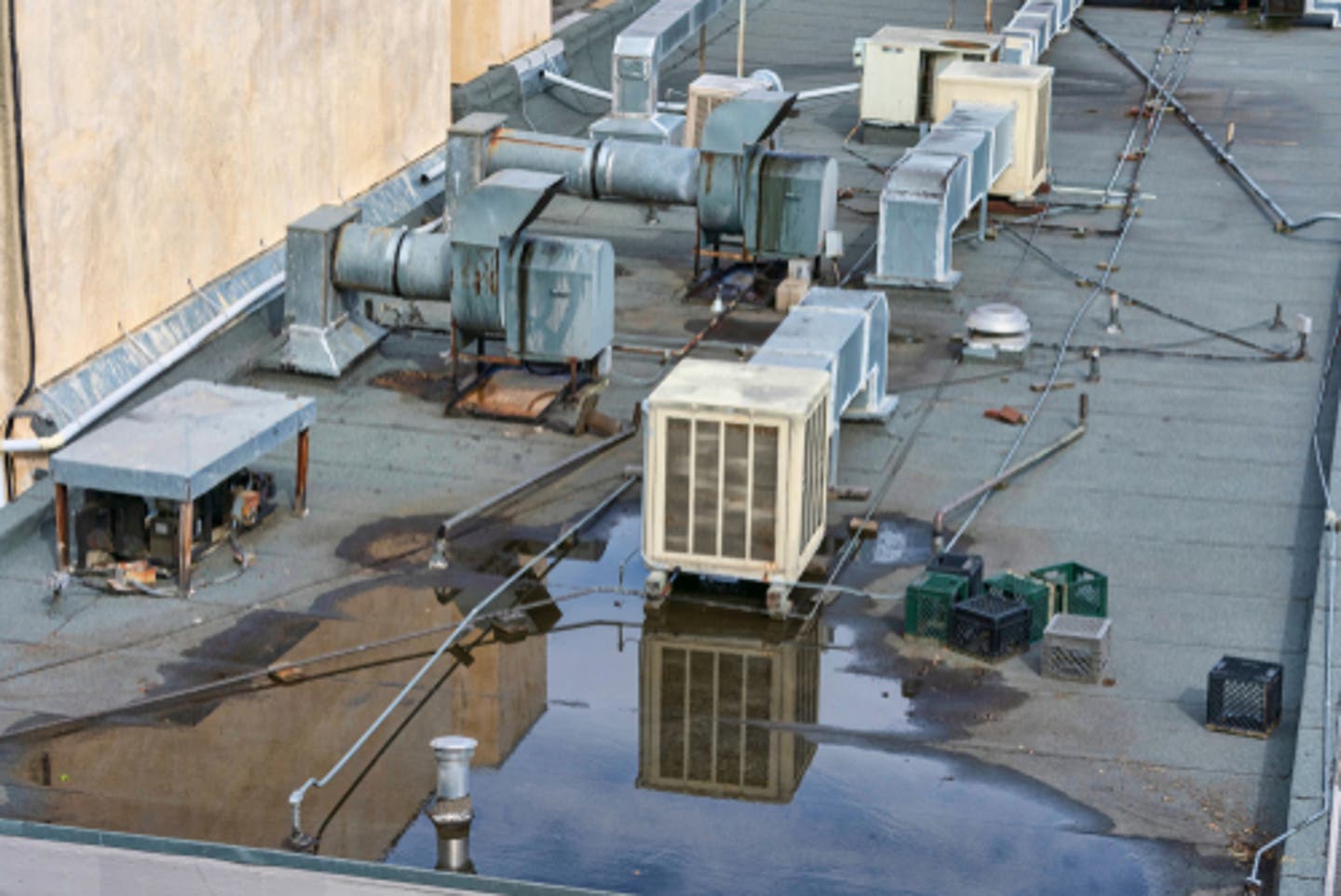
Your commercial property might be a business, retail shop, restaurant, or hospital. Just like homes have variations in roofing materials and design, commercial spaces have unique factors to consider when it comes to roofing, too. But how can you help prevent roof leaks, making sure customers, employees, visitors, and other valuable investments are protected? SERVPRO® is Here to Help® answer that question.
Why Do Buildings Have Flat Roofs?
Look around, and you might notice something interesting: most commercial properties have flat roofs. But why? It might seem counterintuitive, as lack of a “pitch” or gradient means standing water can more easily wreak havoc, unlike home roofs, which are usually sloped.
Turns out, commercial properties have flat roofs for the following reasons, according to Medium:
First (and often foremost) is cost savings. Sloped roofs can add dozens of feet to a building, increasing the cost. Because commercial properties tend to be much larger than residential homes, a flat roof is simply more cost effective. Another reason you tend to see flat roofs on buildings is that they provide additional room to place equipment, like water towers, electrical lines, and more. Furthermore, in colder areas, snow is less likely to fall onto the sidewalk or someone walking by if it lands on flat roofs.
Types of Commercial Roofing Materials
According to the Government of the District of Columbia’s Office of Planning, there are two primary types of commercial roofing materials: built-up roofing, and rubber roofing.
Built-up roofing (or a “built-up roof membrane”) is usually made of layers of gravel, felt, and tar (two to three layers’ worth). The tar and felt become a watertight barrier, while the gravel helps to ensure the roof doesn’t lift or blow off in strong winds.
Rubber roofing (or an “elastomeric/plastomeric roof membrane”) is considered a “single membrane system” and tends to be more elastic than built-up roofing, requiring less onsite labor. This roofing involves sheet materials being added to the roof in single layers.
There are a variety of “roof membranes” within this category, including neoprene (a high-performance synthetic rubber), polyvinyl chloride (fairly inexpensive sheets that are joined at the seams by hot air welding or solvent welding), and polymer-modified bitumens (formed into composite sheets, and often adhered to the roof deck, or laid loose).
Common Causes of Commercial Roof Leaks and Damage
The U.S. General Services Administration outlines the following reasons flat, commercial roofs suffer water leaks and other damage:
Water. As water builds on a flat roof, it can enter cracks and fissures, leaking inside the building. It might also freeze, tearing the roof up or causing it to lurch.
Sun. The ingredients in asphalt or tar might evaporate if under hot temperatures. Otherwise, the asphalt might oxidize and become very fragile. Overly hot temperatures might also cause the roof’s surface coating to flake off as it loses its stretchiness, exposing the roof’s felt to the elements.
Changes in temperature. Whether the air is hot or cold, expanding and contracting roof materials can cause the deck, walls, and flashing of roof structures to strain. As the roof mat tears, and joints crack, water may find openings inside.
Wind. Even flat roofs can suffer from strong wind, which may cause roof seams to tear, or push rain into defective joints in the mat or roof parapet.
Outside interference. Items like electrical wires, signs, or even acids and pollutants might damage membrane roofing or roof mats. Additionally, anchorage planks, which pierce the mat and deck, can cause considerable damage.
Settlement. Strain might be exerted on flashings when walls settle. Similarly, roofs might settle below the level of a drain pipe, which might cause floodwater to back up, or cracks to appear around the drain.
Commercial Roofs: How to Prevent Leaks
In addition to the U.S. General Service Administration’s recommendation to install coatings and/or ballast coverings, Forbes recommends other steps to help prevent roof leaks. While not all-inclusive, some highlights include regular maintenance to survey the roof. Fill cracks with caulk, and install flashing to help redirect water away from the foundation. If any part of your roof has shingles, these should be inspected and replaced if damage occurs.
Furthermore, Architect Magazine recommends placing walkways in direct lines for servicemen and technicians. These walkways should be the shortest distance from where roof access starts, to where service will take place. (As Architect Magazine notes, it is unlikely a repairmen will take the long way to fix machinery or adjust a solar panel.)
Ultimately, cover boards should be placed beneath roof membranes. This will help prevent damage if tools or maintenance equipment is dropped on the roof, or other potential destruction occurs. By lessening damage, you can help prevent cracks or openings to appear, seams to pop, or joints to break, which can contribute to roof leaks if unnoticed.
For Commercial Roof Leaks, Contact SERVPRO 24/7
Commercial roofs commonly have industrial equipment, including air conditioning units and electrical appliances, placed up top, requiring routine maintenance and heavy foot traffic. That’s why a sturdy roof is required in commercial properties. Unfortunately, a leaking roof can cause serious destruction, including water damage, mold damage, and even stained ceilings, walls, floors, and more. But with 2350 SERVPRO locations in the United States and Canada, there is a SERVPRO nearby, operating 24/7 to help restore your property to pre-loss condition.
Established in 1967, SERVPRO has grown to become the #1 Choice in cleanup and restoration. Read our FAQ and Glossary to learn more about the industry, and explore our site to discover more about the services we offer. SERVPRO is available in Canada and all 50 states, and always here to help.